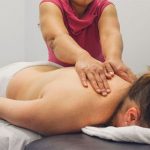 The act of manipulating soft tissue in the hope of increasing circulation and keratinization, and enhancing tissue tone. Data documenting the treatment efficacy of this procedure is not currently available.
The act of manipulating soft tissue in the hope of increasing circulation and keratinization, and enhancing tissue tone. Data documenting the treatment efficacy of this procedure is not currently available.
An ancient hands-on therapy that is used to: induce mental and physical relaxation; eliminate toxins from the body; improve muscle tone and circulation; and help the digestive system to function effectively.
A treatment for muscular conditions which involves rubbing, stroking or pressing the body with the hands.
Manipulation of the soft tissues of the body through rubbing, stroking, kneading, or gripping to improve muscle tone, relax the person, or improve circulation.
A technique that may be used in physical therapy or by a massage therapist involving a kneading with the hands of certain soft tissues of the body, especially the muscles, ligaments, and tendons. The purpose of massage is to promote relaxation of the body part being massaged and to relieve overall physical tension in the person receiving the massage. Muscles are relaxed by kneading the muscle tissue through the skin, most commonly in the areas of the neck, shoulders, and back, but also in other parts of the body. When muscles are compressed against underlying bone during massage, muscular tightness and spasm may be relieved. Massage also brings increased blood flow to the muscles involved, which warms and relaxes them.
Manipulation of the soft tissues of the body with the hands. Massage is used to improve circulation, reduce edema where present, prevent adhesions in tissues after injury, reduce muscular spasm, and improve the tone of muscles.
A method of treatment in which the operator uses his or her hands, or occasionally other appliances, to rub the skin and deeper tissues of the person under treatment. It is often combined with (a) passive movements, in which the masseur/masseuse moves the limbs in various ways, the person treated making no effort; or (4) active movements, which are performed with the combined assistance of masseur/masseuse and patient. Massage is also often combined with baths and gymnastics in order to strengthen various muscles. It helps to improve circulation, prevent adhesions in injured tissues, relax muscular spasm, improve muscle tone and reduce any oedema.
Manipulation, methodical pressure, friction, and kneading of the body.
A therapy in which muscle and connective tissue are manipulated to enhance function of those tissues and promote relaxation and well-being.
Body therapy technique used by Alternative medicine practitioners. Massage has been used since ancient times. As long ago as the fifth century B.C.E., the Greeks used massage for religious as well as medical purposes. Greek philosophers, including Plato and Socrates, promoted the blessings of massage to relieve pain and prolong human life. Alexander the Great found Indian kings being massaged in the fourth century B.C.E. In ancient China masseurs developed a theory of relations between the skin and internal organs that led to the development of Acupuncture. Famous Romans, including Julius Caesar, the great orator and statesman Cicero, and the famous lawyer Pliny, claimed that massage had cured them of ills such as neuralgia and speech defects. The second-century physician Galen prescribed massage in combination with regular exercise to help patients keep fit.
Massage fell out of favor in the West during the medieval period, perhaps because of the influence of the Catholic Church, which frowned on manipulation of the body. It was rediscovered and applied by Renaissance physicians. When Mary Queen of Scots fell ill with typhus, fainted, and was given up for dead, her doctor, a man named News, massaged her until she recovered consciousness.
Manual or mechanical manipulation of the body by rubbing, gently pinching, kneading, tapping, and other movements to increase metabolism and circulation, promote absorption, and relieve.
This practice involves delicately applying pressure and manipulating the exterior layer of the physique to promote the circulation of blood, mitigate the effects of anxiety on the nervous system, and induce a state of relaxation in the muscles.
Applying pressure and manipulation to specific body regions, often using the hands. Massage enhances blood circulation and induces muscle relaxation. It can be utilized to alleviate muscle spasms, address muscle injuries, and diminish edema, which is the buildup of fluid in body tissues. While massage is most potent when administered by another individual, self-massage can also alleviate pain stemming from muscle tension.
The therapeutic manipulation of bodily tissues, including techniques like stroking, kneading, or tapping, performed either manually using the hands or with the assistance of a device like a vibrator.
